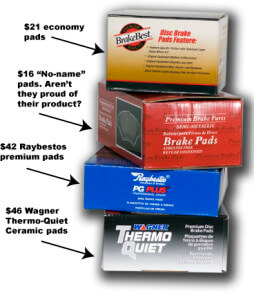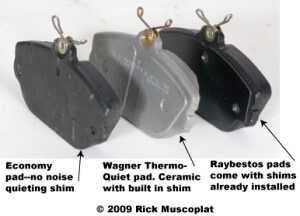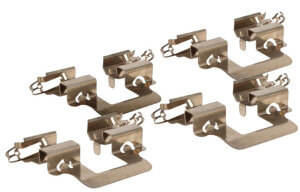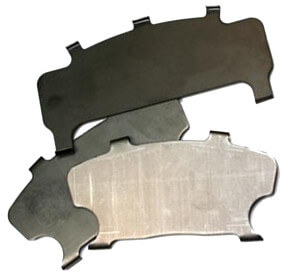Brake squeaking when stopping
Brake squeaking when stopping
Brake squeaking when stopping is common and is usually caused by improper installation, worn brake pad friction material, worn brake rotors, or seized brak components.
What is brake squeaking?
Brake squeaking/squealing is actually a medium frequency noise in the 300Hz to 5,000Hz range in the 0 to high 50’s dB range. It’s caused by vibration between the brake pad friction material and backing plate or shoe and the caliper or brake plate.
When new brakes are installed, the technician installs new anti-rattle clips that prevent the brake pad backing plate “ears” from vibrating in the abutment or caliper bracket areas. They also apply a dab of high temperature synthetic brake grease in that same area to dampen the vibrations.
They also install noise reduction shims that dampen the transfer of vibrations from the friction material to the caliper. Noise reduction shims can be as simple as a stamped piece of aluminum to more complicated multi-layer designs with elastomeric vibration absorbing layers between metal layers.
Finally, the technician applies a thin layer for brake grease to the back of the noise reduction shim to further reduce vibration transfer to the caliper.
Degradation of vibration reduction components causes brake squeal when stopping
When the anti-rattle clips, brake grease and noise reduction shims degraded they lose their vibration dampening qualities. Vibrations that normally are outside the hearing range are then transferred to the brake caliper, spindle and steering knuckle where they are amplified, causing an irritating squeal.
Worn friction material causes brake squeaking when stopping
New brake pads contain a certain quantity of friction material sufficient to dissipate heat, absorb and dampen vibration while still providing adequate stopping power and long life. As the friction material wears down to its service limit, the reduced mass, can’t dampen normal brake vibration sufficiently, so it transfers the vibration to the caliper, which amplifies it.
Brake pad backing plate rust and corrosion cause brake squeal
Brake pad backing plates are made from steel and often painted with an anti-corrosive coating. Over time that anti-corrosive coating degrades, exposing the steel to water and road salt which causes it to corrode. Rusted brake pad backing plates degrade the noise dampening ability of the brake pad and the noise reduction shim.
Rust on rotors causes brake squeal.
All rotors rust. Most surface rust is wiped away with successive brake applications. However, if rust is left for long periods, the rotor surface begins to pit and that rust can cause brake squeal.
Non-parallel rotor fitment causes brake squeal.
The brake rotor must fit perfectly parallel with the wheel hub to ensure full brake pad to rotor face contact. Corrosion on the surface of the wheel hub or distortion of the wheel hub itself causes lateral runout or wobble. That wobble results in uneven wear on opposite sides of the rotor. If the brake pads are of the adherent design, the runout will cause the uneven deposit of friction film on opposite sides of the rotor. Or, if the brake pads are of the abrasive style, lateral runout will cause uneven rotor face wear. This uneven deposit or wear eventually causes brake judder or pedal pulsation. However, before it gets to that point, it can also cause brake squeal.
Corroded slide pins cause brake squeal
The caliper must move smoothly and retract easily during brake application and release. If the slide pins are corroded, the caliper can stick, causing the brake pads to overheat and glaze, resulting in brake squeal.
Corroded caliper piston or worn square cut o-ring can cause brake squeal.
The caliper must move smoothly and retract easily during brake application and release. If the piston is corroded due to a breach of the dust boot or the square cut O-ring is worn, hardened or damaged, it can cause the piston to stick and not release, causing the brake pads to overheat and glaze, resulting in brake squeal.
Stop brake squeaking when stopping
“My brakes squeal” is the most common complaint from drivers. If you’ve recently replace the brakes yourself and now the brakes squeal, or you’ve had them replaced at a shop and now have brake noise, chances are the brake job wasn’t done properly. Here are the steps you can take eliminate the problem.
In the automotive industry, brakes squeal is common referred to as NVH, Noise, Vibration, Harshness
Step 1: Buy high quality brake pads. Economy, “no-name,” and many

Brake pads come in different quality levels
private labeled store brands are made with older less expensive friction materials that are pretty much guaranteed to make brakes squeal. They’re also made with low quality steel backing plates that corrode. See this post on backing plate corrosion.
High quality pads come with new noise reducing shims and new anti-rattle clips (where factory equipped). Noise reduction shim quality varies widely. Cheap brake pads have cheap noise reduction shims that simply don’t dampen the transfer of brake vibration. If you buy a set of pads and they don’t come with shims or clips, buy them separately.S ee this post on the noise reduction shims.
You CANNOT reuse old shims or clips—well, unless you want to hear your brakes squeal.

Read this post on brake pads and brake jobs
Step 2: Clean everything. When cast iron and steel come in contact with water and humidity, they form rust. Since rust expands as it forms, it can cause brake parts to bind. The most common example of this is between the hub and the rotor hat area, and between the brake abutment or caliper bracket and the anti-rattle clips. This phenomenon is called “rust jacking.” When it occurs between the hub and rotor hat, it cocks the rotor, causing lateral runout and disc thickness variation. Read this post to learn more about brake pedal vibration and pulsation.

Anti-rattle clips
However, when rust jacking occurs between the abutment and the anti-rattle clips, the decreased clearance causes the pad ears to bind against the clips. That causes uneven pad wear, brakes squeal, vibration, overheating, and premature failure.
So wire brush the abutment areas and apply a thin coating of high temperature brake grease before installing the anti-rattle clips. Do NOT lube the clips. That’ll just accumulate brake and road dirt.
Step 3: Install new shims. Brakes squeal is caused by vibration between the rotor and pads. The rotor acts like an LP record and the pads act as the stylus. Wherever the brake pad backing plate comes in contact with the caliper there’s the opportunity to transmit the vibration. Noise reduction shims act as insulators. Many companies recommend applying high temperature brake grease to the shims where they come in contact with the caliper.
the rotor and pads. The rotor acts like an LP record and the pads act as the stylus. Wherever the brake pad backing plate comes in contact with the caliper there’s the opportunity to transmit the vibration. Noise reduction shims act as insulators. Many companies recommend applying high temperature brake grease to the shims where they come in contact with the caliper.
Several aftermarket manufacturers also sell disc quieting products that act to glue the brake pad backing plate to the caliper surface. Use these products ONLY if your vehicle was designed without noise reduction shims. Do NOT apply these products to noise reduction shims. See this quote from the April ’15 issue of Motor Magazine.
“Disc brake quiet is a gluelike product that’s marketed by several manufacturers. Its purpose is to stop brake squeal and noise by dampening vibration at the caliper/brake pad interface. Manufacturers also claim it provides a tighter fit, allows for easier disassembly and protects against corrosion. The important thing to be aware of is that this product contains an elastomeric polymer and is designed for use with brake pads that do not have antisqueal pad shims. Use of this product with pad shims may actually be detrimental.”
— Karl Seyfert Motor Magazine, April 2015
Step 4: Clean the caliper slide pins/bolts and lube with fresh high temp brake grease
©, 2015 Rick Muscoplat
Posted on by Rick Muscoplat